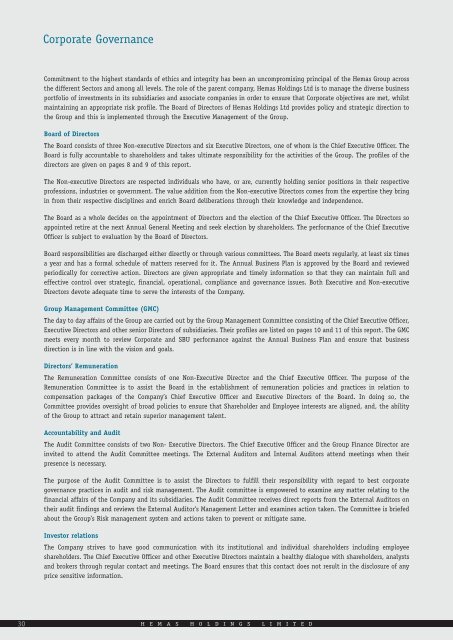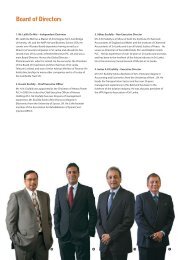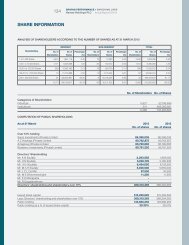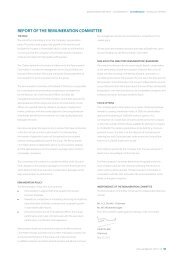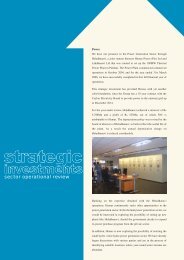Annual report for 2004/05 - Hemas Holdings, Ltd
Annual report for 2004/05 - Hemas Holdings, Ltd
Annual report for 2004/05 - Hemas Holdings, Ltd
- No tags were found...
You also want an ePaper? Increase the reach of your titles
YUMPU automatically turns print PDFs into web optimized ePapers that Google loves.
Corporate GovernanceCommitment to the highest standards of ethics and integrity has been an uncompromising principal of the <strong>Hemas</strong> Group acrossthe different Sectors and among all levels. The role of the parent company, <strong>Hemas</strong> <strong>Holdings</strong> <strong>Ltd</strong> is to manage the diverse businessportfolio of investments in its subsidiaries and associate companies in order to ensure that Corporate objectives are met, whilstmaintaining an appropriate risk profile. The Board of Directors of <strong>Hemas</strong> <strong>Holdings</strong> <strong>Ltd</strong> provides policy and strategic direction tothe Group and this is implemented through the Executive Management of the Group.Board of DirectorsThe Board consists of three Non-executive Directors and six Executive Directors, one of whom is the Chief Executive Officer. TheBoard is fully accountable to shareholders and takes ultimate responsibility <strong>for</strong> the activities of the Group. The profiles of thedirectors are given on pages 8 and 9 of this <strong>report</strong>.The Non-executive Directors are respected individuals who have, or are, currently holding senior positions in their respectiveprofessions, industries or government. The value addition from the Non-executive Directors comes from the expertise they bringin from their respective disciplines and enrich Board deliberations through their knowledge and independence.The Board as a whole decides on the appointment of Directors and the election of the Chief Executive Officer. The Directors soappointed retire at the next <strong>Annual</strong> General Meeting and seek election by shareholders. The per<strong>for</strong>mance of the Chief ExecutiveOfficer is subject to evaluation by the Board of Directors.Board responsibilities are discharged either directly or through various committees. The Board meets regularly, at least six timesa year and has a <strong>for</strong>mal schedule of matters reserved <strong>for</strong> it. The <strong>Annual</strong> Business Plan is approved by the Board and reviewedperiodically <strong>for</strong> corrective action. Directors are given appropriate and timely in<strong>for</strong>mation so that they can maintain full andeffective control over strategic, financial, operational, compliance and governance issues. Both Executive and Non-executiveDirectors devote adequate time to serve the interests of the Company.Group Management Committee (GMC)The day to day affairs of the Group are carried out by the Group Management Committee consisting of the Chief Executive Officer,Executive Directors and other senior Directors of subsidiaries. Their profiles are listed on pages 10 and 11 of this <strong>report</strong>. The GMCmeets every month to review Corporate and SBU per<strong>for</strong>mance against the <strong>Annual</strong> Business Plan and ensure that businessdirection is in line with the vision and goals.Directors’ RemunerationThe Remuneration Committee consists of one Non-Executive Director and the Chief Executive Officer. The purpose of theRemuneration Committee is to assist the Board in the establishment of remuneration policies and practices in relation tocompensation packages of the Company’s Chief Executive Officer and Executive Directors of the Board. In doing so, theCommittee provides oversight of broad policies to ensure that Shareholder and Employee interests are aligned, and, the abilityof the Group to attract and retain superior management talent.Accountability and AuditThe Audit Committee consists of two Non- Executive Directors. The Chief Executive Officer and the Group Finance Director areinvited to attend the Audit Committee meetings. The External Auditors and Internal Auditors attend meetings when theirpresence is necessary.The purpose of the Audit Committee is to assist the Directors to fulfill their responsibility with regard to best corporategovernance practices in audit and risk management. The Audit committee is empowered to examine any matter relating to thefinancial affairs of the Company and its subsidiaries. The Audit Committee receives direct <strong>report</strong>s from the External Auditors ontheir audit findings and reviews the External Auditor’s Management Letter and examines action taken. The Committee is briefedabout the Group’s Risk management system and actions taken to prevent or mitigate same.Investor relationsThe Company strives to have good communication with its institutional and individual shareholders including employeeshareholders. The Chief Executive Officer and other Executive Directors maintain a healthy dialogue with shareholders, analystsand brokers through regular contact and meetings. The Board ensures that this contact does not result in the disclosure of anyprice sensitive in<strong>for</strong>mation.30H E M A S H O L D I N G S L I M I T E D


